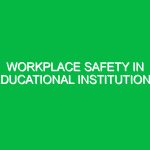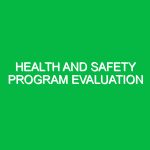Event management is a multifaceted industry, intricately woven with the threads of logistics, creativity, and safety. At the heart of every successful event lies robust safety protocols, especially under the Health, Safety, and Environment (HSE) domain. This article delves deep into the essential safety protocols for event management, emphasizing their significance in preventing accidents, ensuring compliance, and fostering a safe environment for attendees and staff alike.
Understanding Safety Protocols for Event Management
Safety protocols for event management refer to a set of established guidelines and procedures aimed at minimizing risks and ensuring the health and safety of everyone involved in an event. These protocols cover a broad spectrum of activities, including crowd management, emergency response, venue safety, and food handling. Their relevance in the HSE domain cannot be overstated; they serve as a preventive measure against unforeseen incidents that could lead to injury or property damage.
For instance, consider the chaotic aftermath of a large outdoor concert where safety protocols were either poorly implemented or ignored. In 2019, a music festival in the UK faced significant backlash after a series of injuries due to overcrowding and inadequate crowd control measures. The incident highlighted the dire need for stringent safety protocols and effective event management strategies to safeguard participants. Such events underscore the importance of having a comprehensive safety plan in place.
Identifying Hazards and Risks Associated with Event Management
Every event, regardless of its size or type, carries inherent risks. Identifying these potential hazards is the first step in establishing effective safety protocols for event management. Below are some common risks:
Crowd-Related Risks
Crowd dynamics can be unpredictable. Overcrowding can lead to trampling, suffocation, and panic. At major events like marathons and concerts, managing crowd flow becomes crucial. For example, during the 2015 Love Parade in Duisburg, Germany, overcrowding resulted in a tragic stampede, claiming 21 lives and injuring hundreds. Such incidents reveal the critical need for effective crowd management strategies.
Venue-Related Hazards
The physical environment can pose various risks. Poorly maintained venues can lead to slips, trips, and falls. Inadequate lighting, obstructed exits, and faulty electrical systems can amplify these hazards. For instance, a poorly lit pathway leading to an exit can become a significant risk during an emergency evacuation.
Health Risks
With the ongoing global health concerns, such as the COVID-19 pandemic, health risks associated with events have gained prominence. Close contact among attendees can facilitate the spread of infectious diseases, making health protocols essential. Events must now include measures such as social distancing, sanitization stations, and health screenings.
Food Safety Risks
Food handling at events presents another layer of complexity. Improper food storage, preparation, and serving can lead to foodborne illnesses. The risk escalates in large gatherings where food is served en masse. For example, at a large outdoor festival, if food vendors do not adhere to proper health regulations, they could inadvertently cause food poisoning among attendees.
Best Practices and Safety Precautions
Having identified the hazards, it is essential to implement best practices and safety precautions tailored to mitigate these risks. Here are several actionable strategies:
Crowd Management Strategies
Effective crowd management involves planning for the flow of people, including entry and exit points. Use barriers to guide attendees and ensure clear signage throughout the venue. Trained security personnel should monitor crowd behavior and be ready to intervene if necessary. Regular drills can prepare staff for emergencies, allowing for swift action in case of panic or overcrowding.
Venue Safety Checks
Conduct thorough inspections of the venue before the event. Check for potential hazards such as loose flooring, inadequate lighting, and blocked exits. Collaborate with venue management to ensure compliance with local regulations. Emergency exits should be clearly marked and unobstructed at all times. Consider employing a safety officer on site during the event to oversee these aspects.
Health and Hygiene Protocols
To mitigate health risks, implement comprehensive hygiene protocols. Provide hand sanitizing stations at key locations, ensure regular cleaning of high-touch surfaces, and encourage attendees to wear masks if necessary. Consider health screenings at entry points, such as temperature checks, especially in light of recent health crises. Communication is critical here; ensure attendees are informed about the health measures in place ahead of time.
Food Safety Regulations
When it comes to food handling, adhere strictly to food safety regulations. Ensure that all food vendors are licensed and trained in safe food handling practices. Monitor food temperatures and ensure that perishables are stored properly. Regular inspections throughout the event can help prevent foodborne illnesses.
Regulations and Standards Governing Safety Protocols
Various regulations and standards govern safety protocols for event management. These can vary by country and even by local jurisdictions, but some key standards include:
Occupational Safety and Health Administration (OSHA)
In the United States, OSHA provides guidelines that ensure safe working conditions. Event managers must be familiar with OSHA regulations related to crowd safety, electrical safety, and emergency preparedness.
Local Health Codes
Local health departments often have specific codes that govern food safety and sanitation during events. Event organizers must ensure compliance with these codes to avoid fines and ensure attendee safety.
International Organization for Standardization (ISO) Standards
ISO standards, such as ISO 45001, provide a framework for occupational health and safety management systems. Adopting these standards can help event managers systematically identify hazards and implement effective safety protocols.
Conclusion
Safety protocols for event management are not merely regulatory checkboxes; they are essential components of successful event execution. By understanding the potential hazards, implementing best practices, and adhering to relevant regulations, event managers can create a safe environment that prioritizes the well-being of attendees and staff alike. The stories of past incidents serve as stark reminders of the importance of rigorous safety measures. As the event management industry continues to evolve, embracing proactive safety protocols will not only foster trust among attendees but also ensure that events are memorable for the right reasons. Ultimately, a commitment to safety reflects an event’s dedication to its participants, setting the stage for success in every aspect.


